It's a good bet that the forthcoming movie The Lord of the Rings: The Return of the King is going to be pretty good. Peter Jackson's cinematic trilogy, based on J.R.R. Tolkien's seminal series of fantasy novels, is, by all accounts, a huge success, and since the three films were shot back to back to back, we can expect the same kinds of dramatic performances, wondrous scenery, and sheer excitement from the final chapter of this saga that we saw in The Fellowship of the Ring and last year's The Two Towers. This movie series is uncommonly good, which is certainly, in part, why Electronic Arts, the company that nabbed the rights to produce games based on these films, is going all-out for its game adaptations. The new Return of the King game follows closely in the footsteps of last year's hack-and-slash action game, The Two Towers, but picks up at the fever pitch where The Two Towers left off, and it's considerably better overall. It's still a relatively simple and short action game at heart, but a solid combat system, some extremely intense and cinematic levels, cool extras that fans of the movies will enjoy, and the option to play cooperatively with a friend all add up to make The Return of the King deserving of its name.
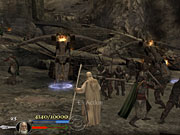
Last year's The Two Towers game included sequences based on The Fellowship of the Ring as well as its sequel. The Return of the King is similar and begins, literally, with the climactic battle of Helm's Deep from The Two Towers. As if to make sure you get a grand first impression, the first level begins automatically when you first load the game--after a brief introductory cutscene that sets the stage for the wizard Gandalf's arrival at the break of dawn with the Riders of Rohan. The defenders of Helm's Deep are being overrun by the evil forces of Sauron, but Gandalf's perfectly timed intervention swings the momentum of the battle in favor of the forces of good, putting Sauron's armies into full retreat. As Gandalf, you'll smash through legions of the villainous uruk-hai, scale the castle walls to assist Aragorn, Legolas, and Gimli, and rupture the enemy's supply lines, all while war wages all around you. This first level suitably captures the chaos and frenetic pacing of the battle from The Two Towers, and, aside from the fact that you can't actually lose here, it's par for the course in The Return of the King: All the levels in the game are as spectacular as they are frantic.
Once you've won the battle of Helm's Deep, you're presented with the nicely done stage select screen, from which you'll also be able to access the game's various bonus features, as you unlock them. The game primarily consists of three sets of levels, which are modeled after the separate paths taken in The Return of the King by Gandalf, Aragorn, and Frodo, the ring bearer. The "path of the wizard" and the "path of the hobbit" are shorter than Aragon's "path of the king," but to finish Aragorn's path, you'll first need to finish the other two. This structure properly reflects how these characters are forced to go their separate ways in The Return of the King, but it also reflects how their efforts are for a common cause: the destruction of the One Ring and, with it, the elimination of Sauron, his general, Saruman, and their terrifying armies. Each of the three paths can be attempted in any order, but, as you'd expect, you need to finish the missions of each path in order.
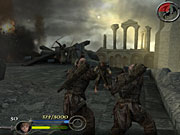
Also as you'd expect, The Return of the King reveals much of the plot of the forthcoming film, though without being too specific. The game's storyline, in and of itself, is actually quite disjointed and assumes players' familiarity with the material. That is, if you didn't know anything about the story of The Return of the King, then the story of the game may be hard to follow, though you'll still get the gist of it. Many people already basically know how this story ends from having read Tolkien's trilogy of novels, but in case you don't want any aspect of the movie spoiled for you, it'd be wise to hold off on playing The Return of the King until after you've seen the movie. For what it's worth, The Return of the King actually includes very few video sequences from the movie on which it's based. The full-motion video is used pretty sparsely, in general, and most of it comes from The Two Towers.
The Return of the King includes a variety of playable characters. In the path of the king, you'll be able to choose from Aragorn the ranger, Legolas the archer, or Gimli the dwarf. You'll play as Gandalf in the path of the wizard, but rather than play as Frodo in the path of the hobbit, you'll actually take control of his faithful friend Samwise. Even if you played the similar Two Towers game, you might expect each of these different characters to have vastly different repertoires of moves, or you might expect that each requires considerably different tactics, but that's really not the case. While the speed and style of the characters' respective slashing attacks is somewhat different, each is comparably powerful and capable of holding his own. Purists may find it a little ridiculous that the diminutive Sam is about as good at slaying legions of uruk-hai as a seasoned warrior like Gimli and that the ranged attacks of the expert archer Legolas aren't really any faster or better, in practice, than those of any other character. However, for the purposes of gameplay, these similarities are fine. They basically mean that you can concentrate on mastering the game's parrying and combo system rather than relearning the controls for each of the game's characters.
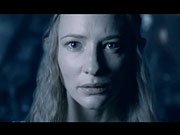
As in The Two Towers, the action in The Return of the King rewards players for cleanly cutting down their foes in rapid succession. The controls for all the characters are identical: You may execute fast attacks, fierce attacks, physical attacks for knocking opponents back or knocking them over, killing moves for vanquishing opponents who've fallen down, ranged attacks for shooting enemies or other targets from afar, and parrying moves for deflecting enemies' blows. You may also use certain objects in the environments, such as spears, catapults, torches, and gate latches. Some of the characters have unique abilities. For instance, Sam can use his magical cloak to temporarily disappear from his enemies' sight, whereas Gandalf can create a defensive barrier about him. These aren't essential skills and don't really change the way these characters play, but they do help provide some differentiation. More importantly, as in The Two Towers, your characters gain experience levels as they fight, which grants them access to new combos and other improved abilities which can be purchased between levels by using the experience points you've accrued. The more efficiently you fight, the more experience points you gain, which is a good system that suitably encourages you to do more than just mash on the attack buttons.
New to The Return of the King are "fellowship upgrades," which are options to spend more experience points to unlock a combo or other ability for use with not only the character you're currently playing as but with all the selectable characters--provided they are of sufficient level. This way, when you're playing as lower-level characters in the other paths of the game, as soon as they level up during a battle, you'll be able to start using the abilities you've already unlocked. Most of the unlockable combos and other abilities in the game can be purchased for the entire fellowship, and The Return of the King offers more higher-level skills than The Two Towers did, which gives you a bit more incentive to keep playing after you've finished the main missions. Also, once you've finished the game, you may play any of the game's levels as any of the game's characters, allowing you to experience some rather goofy "what if" scenarios.
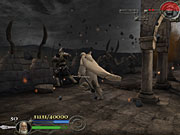
At its core, the combat in The Return of the King is simple. One catch is that enemies who carry shields will automatically deflect your fast attacks, but your fierce attacks will shatter these shields. The enemy AI puts on a convincing show, as many of the missions will put your character and his allies in the middle of pitched battles where combat is occurring all around. Enemies who have noticed you will tend to lunge in with an attack, then dance around and intermittently stab at you some more. The enemies will also do a good job of surrounding you as they rush in from every direction. If you attack at the same time as an opponent, neither one of you gets hurt, so it's the same as parrying a blow. Parrying requires no real timing. Keep tapping the parry button and a frontal attack will never penetrate your defenses. The various combos don't require much in the way of timing, either, though link moves--which you can use to instantly kill certain enemies after parrying their blows--can be a little tricky to get the hang of.
These countermoves automatically put you in "perfect mode," a temporary state from which you'll get maximum experience whenever you kill foes. Repeatedly using combos while avoiding getting hit will also put you in this zone. The game doesn't penalize you for using the same combo over and over, either. In fact, some of the earliest combos you acquire are also some of the most useful, and though the effects of each combo are slightly different for each character, the combos themselves are performed using the same button sequences. You'll take damage pretty often in the game's levels, but enemies will occasionally drop health potions, which instantly restore a portion of your life and keep you going. The core gameplay of The Return of the King has just enough depth to be interesting, and it's got a pretty good feel to it overall.
The level design is really what makes this game such a thrill to play through, at least once. Each level effectively conveys the chaotic feel and epic scale of the outstanding battle sequences from The Lord of the Rings movies. Enemies number in the hundreds, and the sounds of warfare constantly fill the air. Massive explosions, collapsing walls, and a constant sense of danger combine to make you feel like you're really there in the thick of these seemingly hopeless battles. The levels are almost completely linear, and the camera perspective automatically tracks you to give an ideal vantage point for the relentless action. Sometimes you'll find yourself fighting from an awkward angle, like from too far into the background, but this is rarely an issue. Conveniently, characters standing between you and the camera angle (like when the camera tilts closer to ground level) will become semitransparent, ensuring that you pretty much never lose sight of where you stand.
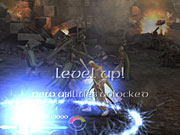
The levels are completely and meticulously scripted and play out in much the same way each time. That diminishes the game's replay value, but it also gives you the prescience of knowing what to expect as you inevitably retry some of the tougher sequences. Some levels have one or more checkpoints, at which you may restart if you lose all your health or otherwise fail your mission, but other levels force you to start over from the beginning. At the normal difficulty setting, many of the levels in the game are surprisingly challenging, as you'll often find yourself racing against time or trying to defend other characters rather than just trying to defend yourself. More-casual players, fortunately, have the option to switch to an easy difficulty setting, but there is a hard mode as well. At any rate, the game isn't overly difficult, but, by all means, it's tough enough to help sustain the illusion that you're at the center of these incredible, against-all-odds conflicts.
Many players wished that The Two Towers offered a cooperative multiplayer mode, especially since you'd often find yourself fighting alongside computer-controlled allies. The Return of the King provides this option, and it works as well as can be expected. The challenge ramps up to make it worth two players' while, and, though there's not much in the way of new tactics to be found in the two-player version of the game, it's still inherently entertaining to go through these often incredible action sequences with a friend. The co-op mode is probably the least practical on the PC, where you'll want one player using a gamepad and the other using the default keyboard/mouse controls (which work about as well as the gamepad controls on all the other versions). Meanwhile, the PlayStation 2 version of the game uniquely offers the ability to play the co-op mode online and also supports voice communication using a USB headset. The PC version, unfortunately, doesn't have online support, but The Return of the King's co-op mode is better when played with a friend than with a stranger over the Internet, anyway. Also of note, the GameCube version supports Game Boy Advance connectivity with the GBA version of The Return of the King, which is simply used for the transferring of small amounts of experience points between characters.
The Return of the King looks quite impressive, and each version of the game looks comparably as good. The Xbox version, overall, looks best and boasts the sharpest visuals and the smoothest, most consistent frame rate. The GameCube version is similar, but its frame rate is more prone to fluctuation. The PlayStation 2 version is certainly no slouch, and, while its visuals don't look as sharp as those of the Xbox and GameCube versions, it runs pretty smoothly and boasts the same terrific special effects. The PC version looks great, too, but a top-of-the-line machine is needed to make the game look its best. You may need to run the game at a lower resolution than you're used to in order to get the action to move at an acceptable frame rate. Frame rate issues do affect each version of the game, to varying degrees, and none of the character models for the main characters look all that remarkable, either. They're more in line with their cinematic counterparts than those of the previous game, but they're still pretty flat-looking. All other aspects of The Return of the King's graphics are outstanding. The scenery, colors, and special effects all perfectly mimic the look of the movies. The relative simplicity of the character models allows for tons of characters to be rendered onscreen at once, for dramatic effect. The full-motion video is also of very high quality.
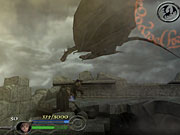
The game's audio is even more effective than the graphics at conveying the intensity of the action. Ian McKellan, as Gandalf, provides original narration for the game and gives the proceedings a truly authentic touch. Sound bites from the other actors are also used to good effect. The now-familiar Lord of the Rings theme blares triumphantly, oftentimes during the combat, but the ambient effects of battle, along with the sounds of your weapons cleaving orc and uruk-hai armor and flesh, are the best part of the audio. As in the movies, there's no truly graphic violence in The Return of the King, but the sound, combined with some of the nastier-looking animations (mostly for the killing moves), makes this combat far from subdued.
The Lord of the Rings: The Return of the King features fast-paced, cinematic action with plenty of pick-up-and-play appeal. It captures the sights and sounds of The Lord of the Rings movies and offers lots of DVD-style extras for fans of the movies. On its own merits, it's not a particularly lengthy or complex game, so you should be able to get through most of its content in a weekend. However, it's a great experience while it lasts, and the Lord of the Rings fan will want to hold on to this one for posterity. It does justice to the movies that inspired it--and that's no small feat.